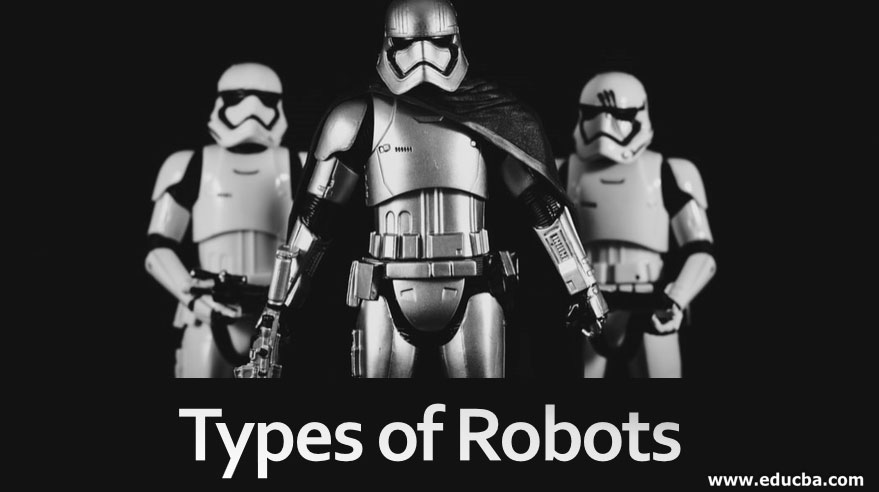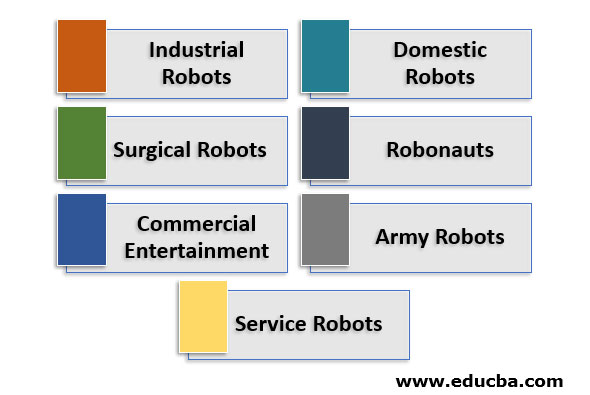Introduction to Types of Robots
The robots are all around us in many forms, many shapes. Robots not necessarily have to look like the machines which Hollywood movies show us. Sometimes robots are made for very simple tasks like cleaning the home or pulling heavy materials etc. In addition, there are some robots, which has been developed for medical purposes, and it can perform surgery as well with the guidance from the doctor. A very popular household robot is the vacuum cleaner robot. These robots are intelligent enough to go back to the charging station when the battery is low and then once charged it can resume at the exact spot from where they left. Like this, there can be many ways to classify robots. Here in this article, we are going to discuss a few major types of robots, which in various industries use to achieve some specific goals.
Types of JIRA Robots
Before getting into various classification mechanisms for robots, let us first look into the internationally approved classification of robots known as JIRA (Japanese Industrial Robot Association). According to JIRA, robots are of following types:
- Manual Handling Device: An operator operates this kind of robot though this kind of robot has some degree of freedom.
- Fixed Sequence Robot: This type of robot can perform a fixed sequence of tasks in a cycle. However, the sequence is fixed and is not programmable.
- Variable Sequence Robot: This type of robot was almost the same as fixed sequence robots except for that these robots are reprogrammable.
- Playback Robot: This type of robot can playback a sequence automatically in a loop.
- Numerical Control Robot: This kind of robot also work through a sequence of instructions. However, the instruction set is numerical.
- Intelligent Robot: Intelligent Robots are the robots that can sense the environment around using the sensors and take a necessary set of actions automatically.
Types of Robots Based on their Application
Now it can be also of various types based on their nature of application and utility. Therefore, let us see in how many ways we can divide the types of the robot based on their application:
1. Industrial Robots
These are the robots that are generally used in the industrial environment for various purposes such as lifting very heavy components or moving parts from one place to another etc. Though these are robots they look mostly like a robotic arm only which is obviously huge in size.
These robotic arms not only help to move components from one place to another apart from these sometimes these are used to perform some repetitive actions like fitting screws or doing durability checks or even sometimes used to assemble components as well. Therefore, these are a highly efficient and useful piece of robotics.
2. Domestic Robots
These kinds of robots are used at the home. These are basically used for cleaning, moping or as a vacuum cleaner. Apart from these, there are some surveillance robots as well which are used in households to increase security.
3. Surgical Robots
These kinds of robots are used for performing surgeries that can be controlled by doctors remotely. These robots generally consist of multiple cameras using which doctors can get a 3d view of the region where the operation is taking place and then can operate accordingly.
4. Robonauts
These are the robots that are used in various space programs. These robots are multipurpose and these can be both humanoid and non-humanoid robots. There are multiple robots that have been sent to space by NASA in recent times to perform multiple actions like collecting the sample, exploring rough surfaces and analyze, taking pictures and sending them back to earth.
Apart from these robots helps NASA to explore the places where it is tough for any astronaut to visit. The prime example of this kind of robotics is the curiosity rovers that were sent to Mars by NASA a few days back. International Space Station also has a lot of robots deployed having separate duties like mobile communication management, environment sensing devices, etc.
5. Commercial Entertainment Robots
This type are generally used for entertainment purposes and is available commercially for sale. Such type of robots are meant to act as a companion and can perform basic tasks like greeting, dancing, walking and other customized action to replicate any pet like dog, cat, etc.
6. Army Robots
Robots that are used in defense, falls in this category. This includes robots that are used for bomb disposal, border surveillance, Drones to capture images and drop tactical weapons, etc. A prime example of such a robot is the robot named ATLAS which is made by Boston Dynamics. This category of robots is not available commercially and generally is kept secret by individual security agencies across the globe.
7. Service Robots
Service robots are those robots that are used in university or R&D teams to implement new features and show them off to the public. These robots are generally used for research purposes only and may be available commercially.
Top 5 Types of Robots as Per the Kinematics
Robots can also be classified as per kinematics. Therefore, as per this parameter, robots are of following types:
1. Stationary Robots: Stationary robots are generally nothing but the robotic arm with a global axis of movement. We can further divide this into a few categories, which are as follows:
- Cartesian Robots: Robotic arm with the capability to move in XYZ coordinate. These robots are rigid structures and expensive with the high maintenance cost of the components.
- Cylindrical Robots: Robots with basic rotation capability. It can move in angular and linear directions.
- Spherical Robots: This type of robot works in a spherical system. It can move in a bi angular and single linear direction.
- SCARA Robots: SCARA stands for Selective Compliance Arm for Robotic Assembly. This type of robot has two parallel revolute joints.
- Articulated Robots: Robots with three revolute joints. This type of robot has been designed to achieve rotary motion.
- Parallel Robots: These are closed-loop systems to support a single platform. An example of this kind of robot would be Flight Simulators.
Apart from the applications mentioned earlier, the manufacturing industry is the most common field where stationary robots find their potential use. For instance, when it comes to choosing a polishing robot for surface finishing on different materials and products, there are various options, such as Cartesian and SCARA, that one needs to consider. Each option has its advantages, disadvantages, and associated costs, which one needs to weigh before deciding.
2. Wheeled Robots: Robots having wheels.
This kind of robots can further be categorized as:
- Single Wheel Robots: As you can probably guess, these are robots having a single wheel.
- Two-Wheel Robots: Robots having two wheels.
- Three and more wheel Robots: Robots having three or more wheels.
3. Legged Robots: Robots with articulated limbs.
These robots can further be divided into the following categories:
- Bipedal Robots (Humanoid Robots): Robots with two articulated limbs.
- Tripedal Robots: Robots with three articulated limbs.
- Quadrupedal Robots: Robots with four articulated limbs
- Hexapod Robots: Robots with six articulated limbs.
4. Swimming Robots: Robots that can swim. Generally, these robots look like fish. An example of such a robot would be a SOFI robot fish developed by MIT.
5. Flying Robots: Robots capable of flying. The drone comes under this category.
Conclusion
Therefore, we can see that robotics has touched our lives in various segments from space to our own households. As robots become more intelligent with time, we can expect the operator intervention to become even less. Here we have tried to categorize robots based on some criteria however in the near future as we continue to explore more segments in robotics, we can expect even greater varies in the world of robotics.
Recommended Articles
This is a guide to Types of Robots. Here we discuss the types of JIRA robots and types based on their application along with the top 5 types as per their kinematics. You can also go through our other suggested articles to learn more –





